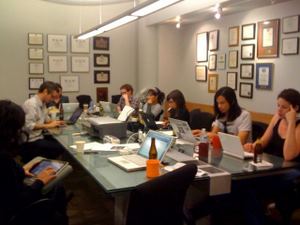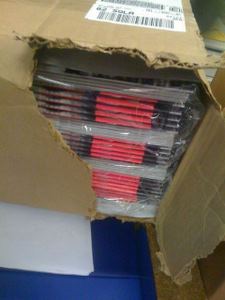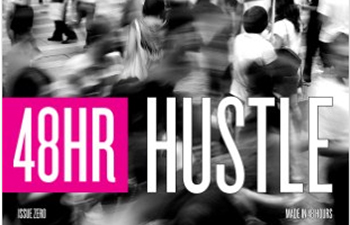The first issue of 48 Hour Magazine, though printed on old-fashioned paper, is one of the most technologically interesting magazine projects today.
The staff of 48 Hour Magazine sent off its finished “Issue Zero” to MagCloud, a print-on-demand service, at noon on May 9 after a harried two-day submission, editing and design process. Following weeks of building buzz about the project, primarily through Twitter, the editors announced the issue’s theme, “Hustle,” at noon on May 7. Contributors then had all of two days (hence the “48 Hour” title) to send in their writing, photos, art and infographics around that loosely defined concept.
Using not only social media, but also a custom-built content management system and a live video stream, the editors, all experienced writers and creative types, crafted a polished magazine through methods that re-imagined the standard magazine publication process from beginning to end. As they describe it, the magazine is “a raucous experiment in using new tools to erase media’s old limits.”
Making a magazine in two days clearly isn’t for every publisher, but the 48 Hour Magazine project demonstrates that even this old medium can be reinvented with technical savvy and creativity.
A Social Media Strategy
The 48 Hour staff began by using their website to solicit the email addresses of people interested in contributing to the magazine. The result was over 5,000 responses. They chose to spread the word about the project primarily through Twitter, avoiding the use of Facebook for the project, partly due to the site’s recent privacy changes.
“I love the connections Facebook enables, but it seems to have little to no respect for its users’ privacy, or ownership of their own creations,” said Mathew Honan, one of the magazine’s editors. Honan said Facebook is increasingly developing a negative public image. “Because of that, the bottom line is that I don’t want our brand associated with Facebook,” he said. “I think Facebook diminishes our brand by association. There are better, less onerous ways to make social connections happen online.”
The Twitter and word-of-mouth marketing strategy seems to have worked. Within that short 48-hour period, the editors received over 1,500 submissions. An intense editing process distilled these to just 70 pieces that fill 60 pages.
Technology on Deadline
Prior to the announcement of the theme, editor Sarah Rich said that managing the submission and editing process was her biggest concern about the project. “We have a workflow plan, but we have to be adaptable enough for it to break down and get rebuilt on the fly if the flood of submissions necessitates it,” Rich said.
Sure enough, challenges arose. Some submissions didn’t make it into the content management system due to technical difficulties. They required individual attention. “That sat like a time bomb until the end of the process, when our copyflow processes got very low-tech,” said Alexis Madrigal, another editor on the project.

Anyone wanting to watch the live video stream of the magazine’s editing processes probably found errors on the streaming site as well. One of the editors’ tweets sent not long before the submission deadline read, “Sorry about the @Ustream feed going down. We’re just scraping by, bandwidth-wise.” But having a transparent, publicly visible editing process turned out to be not just a technical challenge.
“There is a very real tension between transparency and efficiency in these situations,” Madrigal said. “In the editing process, you have to say negative things sometimes, and people are not comfortable saying them in front of a camera. In the future, we’re going to have defined spaces for video and then ‘black boxes’ that are camera-free. We know that the magazine itself is only part of what we’re doing.”
Next, Issue One…and More?
The magazine part of the project, though, has been quite successful so far for a print-on-demand magazine. Over 1,400 copies at $10 each had been sold as of May 14, all via MagCloud. (One recent hiccup is that CBS, which airs a show called “48 Hours,” sent a cease and desist letter to the magazine regarding its name.)
The profit from the small markup the staff added to MagCloud’s printing charges will be divided among contributors, put away as savings for the next issue and used as a grant the magazine will administer. (A full explanation of the magazine’s effort toward financial transparency, plus an amusing and “handy” pie chart, is on their blog.) The editors are also working on getting the magazine into bookstores in the U.S. and abroad.

Madrigal also points to the “positive externalities” of the staff’s work, including providing inspiration to the thousands of people who participated in the project. “I think that participatory global experiences that bring people together around the act of creation are conceptually beautiful,” he said.
Another advantage of the magazine’s print-on-demand publication process is the ability to revise and update content as needed. The edition of the magazine being sold through MagCloud as of this writing is actually version 0.1, in which some contributors’ names have been corrected and added, and a couple of typos were fixed.
In addition to the magazine’s print product, its staff is also posting some of the work from the magazine online. Some people who sent in submissions not selected for publication have suggested on the magazine’s blog that their work could be posted on the magazine’s website instead.
Madrigal said that probably won’t happen, but that the staff is exploring other kinds of online opportunities for the next edition.
“I think we’d like to make our project broader: We’d like to be a high-speed experimental media lab. And that will extend far beyond just doing magazines in two days,” he said.
In the hands of the 48 Hour crew and others willing to experiment and take risks, perhaps not only magazines will be re-imagined by “using new tools to erase media’s old limits.”
Photo of staff by Sarah Rich. Photo of magazines by Mathew Honan.
Susan Currie Sivek, Ph.D., is an assistant professor in the Mass Communication and Journalism Department at California State University, Fresno. Her research focuses on magazines and media communities. She also blogs at sivekmedia.com, and is the magazine correspondent for MediaShift.

